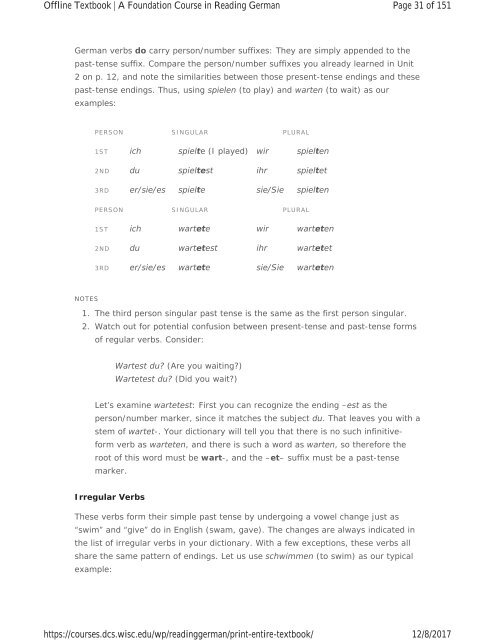A Foundation Course in Reading German, 2017a
A Foundation Course in Reading German, 2017a
A Foundation Course in Reading German, 2017a
Create successful ePaper yourself
Turn your PDF publications into a flip-book with our unique Google optimized e-Paper software.
Offl<strong>in</strong>e Textbook | A <strong>Foundation</strong> <strong>Course</strong> <strong>in</strong> Read<strong>in</strong>g <strong>German</strong><br />
https://courses.dcs.wisc.edu/wp/read<strong>in</strong>ggerman/pr<strong>in</strong>t-entire-textbook/<br />
Page 31 of 151<br />
12/8/2017<br />
<strong>German</strong> verbs do carry person/number suffixes: They are simply appended to the<br />
past-tense suffix. Compare the person/number suffixes you already learned <strong>in</strong> Unit<br />
2 on p. 12, and note the similarities between those present-tense end<strong>in</strong>gs and these<br />
past-tense end<strong>in</strong>gs. Thus, us<strong>in</strong>g spielen (to play) and warten (to wait) as our<br />
examples:<br />
PERSON SINGULAR PLURAL<br />
1ST ich spielte (I played) wir spielten<br />
2ND du spieltest ihr spieltet<br />
3RD er/sie/es spielte sie/Sie spielten<br />
PERSON SINGULAR PLURAL<br />
1ST ich wartete wir warteten<br />
2ND du wartetest ihr wartetet<br />
3RD er/sie/es wartete sie/Sie warteten<br />
NOTES<br />
1. The third person s<strong>in</strong>gular past tense is the same as the first person s<strong>in</strong>gular.<br />
2. Watch out for potential confusion between present-tense and past-tense forms<br />
of regular verbs. Consider:<br />
Wartest du? (Are you wait<strong>in</strong>g?)<br />
Wartetest du? (Did you wait?)<br />
Let’s exam<strong>in</strong>e wartetest: First you can recognize the end<strong>in</strong>g –est as the<br />
person/number marker, s<strong>in</strong>ce it matches the subject du. That leaves you with a<br />
stem of wartet-. Your dictionary will tell you that there is no such <strong>in</strong>f<strong>in</strong>itiveform<br />
verb as warteten, and there is such a word as warten, so therefore the<br />
root of this word must be wart-, and the –et– suffix must be a past-tense<br />
marker.<br />
Irregular Verbs<br />
These verbs form their simple past tense by undergo<strong>in</strong>g a vowel change just as<br />
“swim” and “give” do <strong>in</strong> English (swam, gave). The changes are always <strong>in</strong>dicated <strong>in</strong><br />
the list of irregular verbs <strong>in</strong> your dictionary. With a few exceptions, these verbs all<br />
share the same pattern of end<strong>in</strong>gs. Let us use schwimmen (to swim) as our typical<br />
example:


















